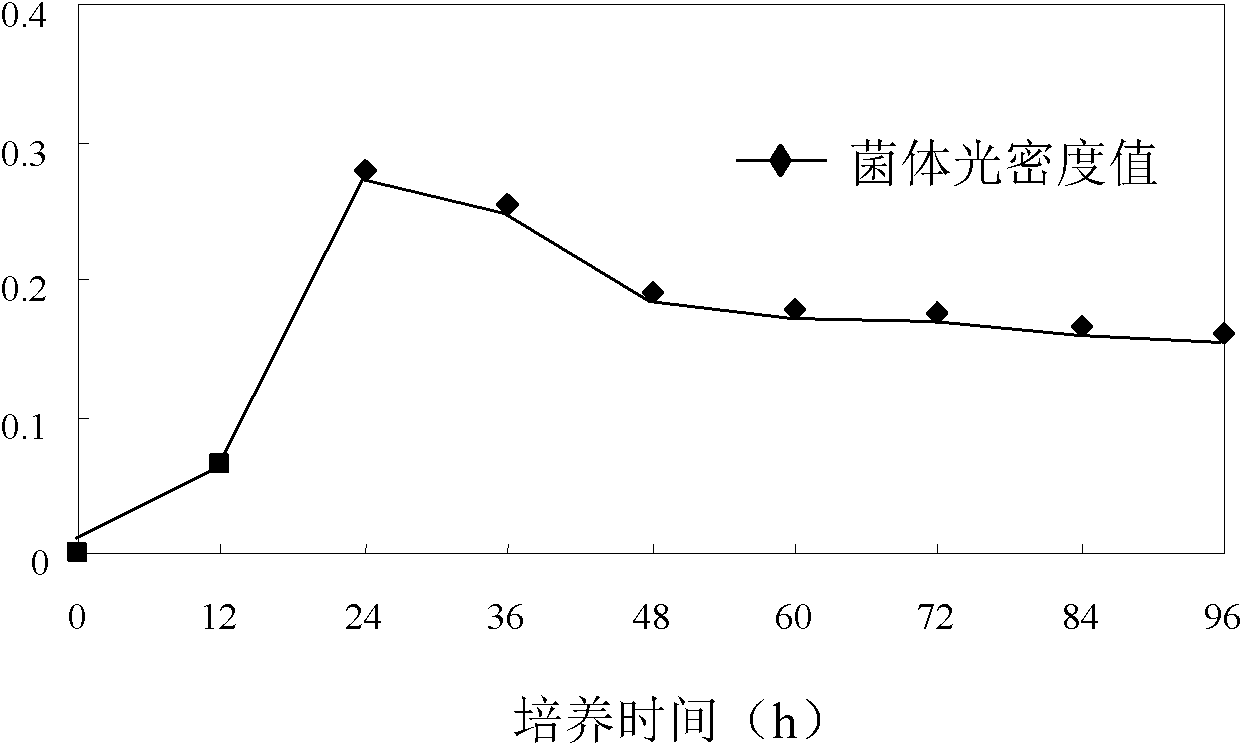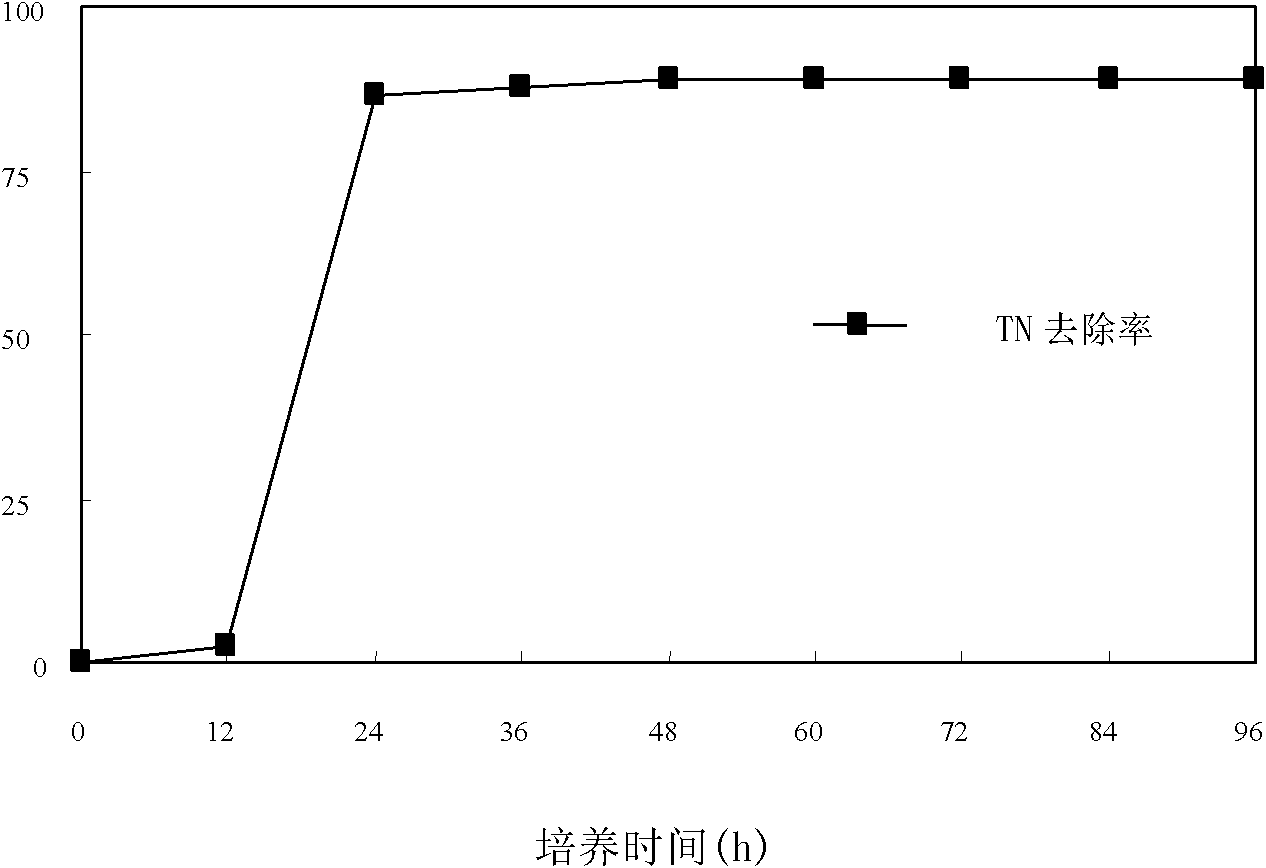Facultatively anaerobic denitrifying bacteria and application thereof in biological denitrification of water body
A denitrifying bacteria and facultative anaerobic technology, applied in the field of environmental microorganisms, can solve the problems of reducing the pollution load into the lake, large fluctuations, etc., and achieve the effects of easy cultivation, rapid growth and reproduction, and a wide range of nitrogen sources
- Summary
- Abstract
- Description
- Claims
- Application Information
AI Technical Summary
Problems solved by technology
Method used
Image
Examples
Embodiment 1
[0038] The isolation and identification of embodiment 1 bacterial strain of the present invention:
[0039] (1) Medium:
[0040] A. Strain isolation, purification, preservation medium ( / L): CH 3 COONa, 2g; Peptone, 15g; Yeast extract, 3g; Glucose, 1g; NaCl, 6g; KNO 3 , 1.5g; the pH is controlled at 7.0-7.2.
[0041] B. Strain screening, denitrifying medium (DM: Denitrifying Medium) ( / L): CH 3 COONa, 2g; KH 2 PO 4 , 0.4g; MgSO 4 ·7H 2 O, 0.6g; CaCl 2 2H 2 O, 0.07g; KNO 3 , 1g; Tris buffer 12mL; trace elements 2mL; pH controlled at 7.0-7.2.
[0042] If the above medium is made into a solid medium, add 1.5% agar.
[0043] (2) Isolation and purification of Pseudomonas stutzeri strain LZ-14:
[0044] Weigh 10g of rhizosphere soil sample of Arundo donax and put it in a 250mL Erlenmeyer flask, add 100mL of sterile water and a few glass beads, and vibrate on a shaker for 15min to disperse the soil sample evenly. After the soil sample is dispersed, let it stand for 5 minut...
Embodiment 2
[0064] The cultivation of embodiment 2 bacterial strains of the present invention
[0065] (1) Medium used
[0066] A. Strain preservation medium ( / L): CH 3 COONa, 2g; Peptone, 15g; Yeast extract, 3g; Glucose, 1g; NaCl, 6g; Agar, 12g; KNO 3 , 1.5g; the pH is controlled at 7.0-7.2.
[0067] B. Strain denitrification medium (DM: Denitrifying Medium) ( / L): CH 3 COONa, 2g; KH 2 PO 4 , 0.4g; MgSO 4 ·7H 2 O, 0.6g; CaCl 2 2H 2 O, 0.07g; KNO 3 , 1g; Tris buffer 12mL; trace elements 2mL; pH controlled at 7.0-7.2.
[0068] If the above medium is made into a solid medium, add 1.5% agar. Sterilize at 121°C for 20 minutes before use.
[0069] (2) Culture conditions
[0070] Use an inoculation loop to scrape 1 ring of bacterial lawn from the Pseudomonas stutzeri strain LZ-14 preserved on the slant of the preservation medium, and inoculate it into a 250mL Erlenmeyer flask containing 200mL preservation medium or denitrification medium, and keep the temperature at 30°C The strain...
Embodiment 3
[0071] Example 3 Denitrification of bacterial strains of the present invention under organic carbon source conditions
[0072] Strain denitrification medium (DM: Denitrifying Medium) ( / L): CH 3 COONa, 2g; KH 2 PO 4 , 0.4g; MgSO 4 ·7H 2 O, 0.6g; CaCl 2 2H 2 O, 0.07g; KNO 3 , 1g; Tris buffer 12mL; trace elements 2mL; pH controlled at 7.0-7.2.
[0073] The denitrification medium was used for inoculation (see Example 1 for the culture method), and the control group was replaced with the same volume of sterilized water. After sealing with a rubber stopper, put it into a constant temperature incubator at 30°C for static cultivation, and take samples every 12 hours to measure and monitor the change of TN, so as to determine the denitrification ability of the strain. See the experimental results image 3 . From image 3 It can be seen that the strain LZ-14 can increase the TN removal rate to more than 80% in a short period of 12-24 hours, and the denitrification is the most...
PUM
 Login to View More
Login to View More Abstract
Description
Claims
Application Information
 Login to View More
Login to View More - R&D
- Intellectual Property
- Life Sciences
- Materials
- Tech Scout
- Unparalleled Data Quality
- Higher Quality Content
- 60% Fewer Hallucinations
Browse by: Latest US Patents, China's latest patents, Technical Efficacy Thesaurus, Application Domain, Technology Topic, Popular Technical Reports.
© 2025 PatSnap. All rights reserved.Legal|Privacy policy|Modern Slavery Act Transparency Statement|Sitemap|About US| Contact US: help@patsnap.com



